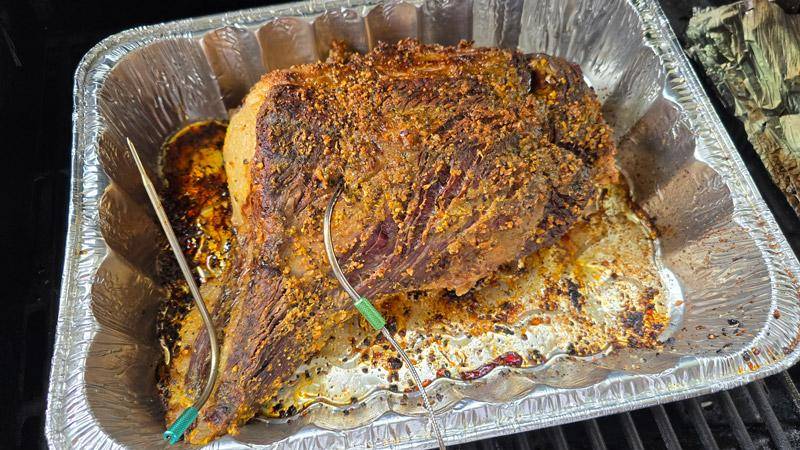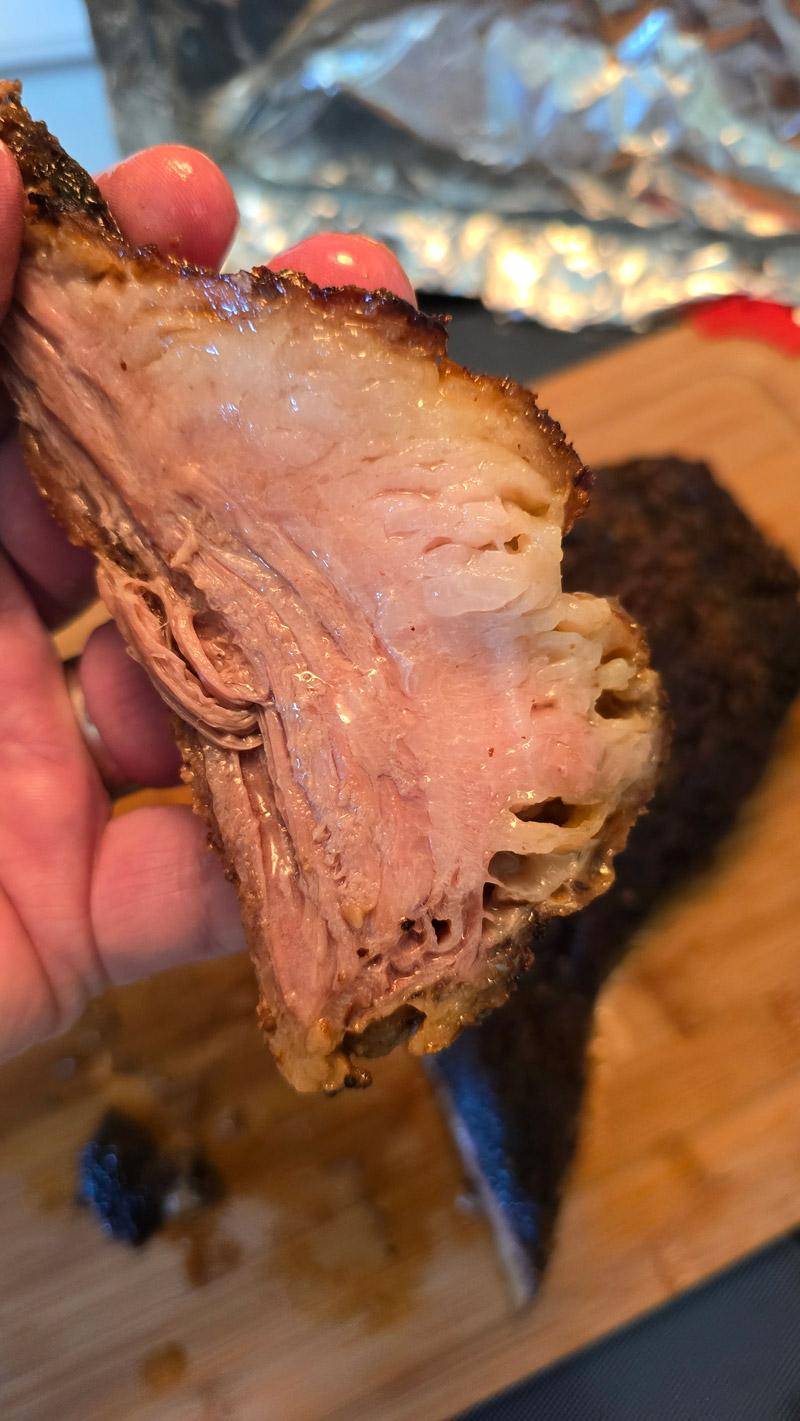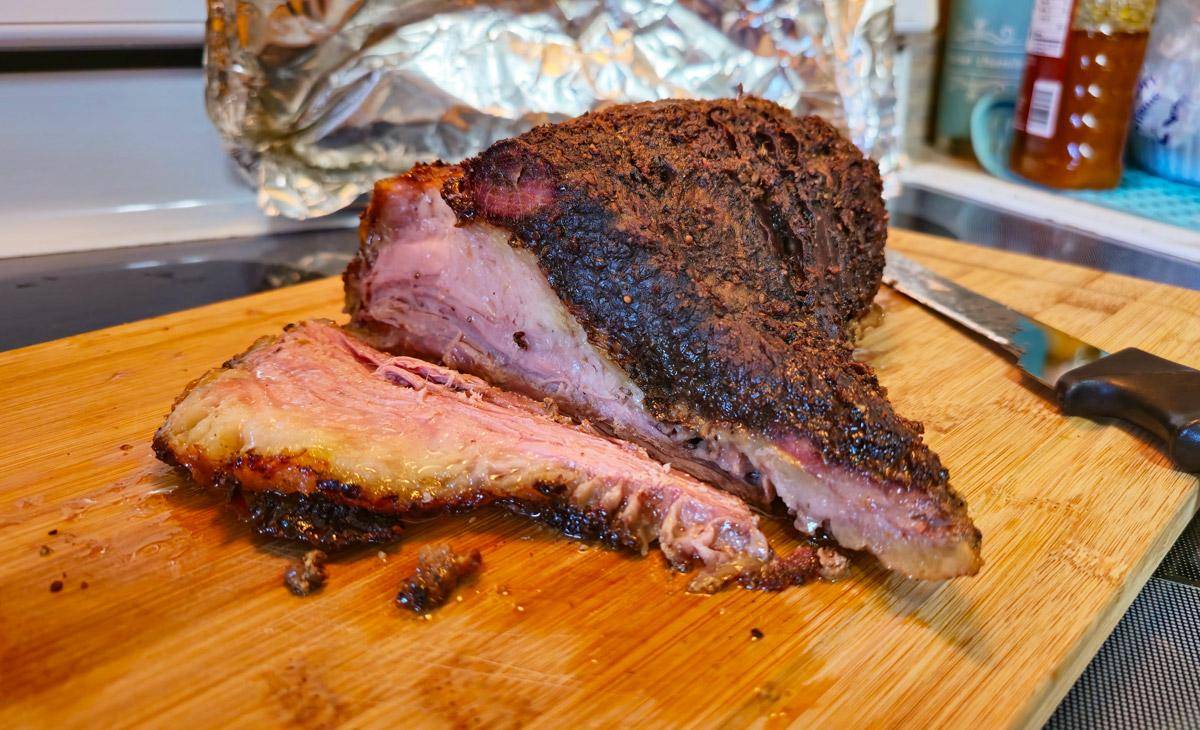When cooking brisket with your son, you'll find numerous opportunities to share valuable science lessons that go far beyond classroom time. This time tending the fire is a unique opportunity for father and son bonding, regardless of whether your son is a teen or an adult - sharing the art of transforming something once considered a worthless scrap into a prized meal that everyone craves is one of the greatest gifts that any dad can give his son. Cooking great brisket is your chance to share life stories and explore science that when combined can prepare him to be a better man and face the future with confidence.
To do this, start by explaining the chemistry of spice rubs, detailing how salt tenderizes meat and sugar caramelizes when heated. Then discuss the science behind fire, focusing on how wood burns and how to control temperature. This is a fantastic chance to also explore how smoke can cook meat slowly without causing it to burn or dry out by talking about thermodynamics and temperature gradients. Finally, its time to explore the true magic of low and slow BBQ as you examine the breakdown of muscle tissue and collagen during cooking. These lessons will enrich your son's understanding of scientific principles while creating a flavorful meal together.
You've got an entire day of cooking ahead of you guys, so take your time, have a beer or some ice tea and enjoy this masculine ritual that men have celebrated for thousands of years while tending the fire preparing a meal for their family!
Who's The Best Cook In Your House?
- Explain how salt in spice rubs breaks down muscle fibers, demonstrating chemistry principles during meat preparation.
- Discuss fire science by observing flame colors and explaining combustion stages while managing the smoker.
- Illustrate heat transfer methods (conduction, convection, radiation) as they relate to cooking the brisket.
- Explore thermodynamics by monitoring temperature gradients and discussing heat movement within the smoker.
- Demonstrate smoke formation physics by explaining wood gasification and how different wood types affect flavor.
Cooking A Great Brisket Is All About Decision Making!
So, before we get too far into this I want to address any haters that might see my photos and tell me all the things I did wrong. This was an experiment, my first time truly doing a BBQ brisket and I have a cheap gas grill - not a professional smoker, I also wasn't going to spend a ton of money trying something out so there was a sale at Kroger for $2.99 a pound last week. It's clear that this was not a PRIME brisket and I probably should have trimmed it better to knock off that dangling part.
Additionally, for anyone who knows - this is the point half, I cut the point from the flat (the part you usually see with corned beef) so it fit better in the grill. Also I didn't want to waste food by cooking too much at one time. However, yeah ... there is a giant lump of fat there ... that's sorta what the point end of the brisket has and I happen to like fatty juicy brisket since you don't need to cover up the beefiness by smothering it in sauce.
Just add a nice rub (I used a mix of season salt, pepper, and garlic with a yellow mustard binder).
The recipe I put together was simple - trim the excess outer fat and any nasty-looking edges, then put on the binder and rub. Then I put it on the grill for at as close to 250-300°F as I could and let it sit till it reached 195 degrees. At about 150°F internal temperature though I covered the pan with foil and created a little chimney so the smoker box (wood chips sitting just slightly exposed from water in a tin) would send the smoke right into the pan to finish off the meat.
Then about 195°F I took the brisket off - this was now 3am and I wrapped it in a blanket on the stove till the next morning. Letting it rest was an essential part of the process.
During this whole process I know I learned a lot and it made me realize that smoking a brisket is more than just "do it this way because that's the way to do it" and instead, has so many elements of science involved. The fun part of science is that while you can have different opinions, things just don't happen randomly. It's ok to have a more pot roasty brisket ... take it off at 205°F then! ... want to dig in immediately and don't care if it's dry? That's ok too, don't let it rest. These things are just like every challenge in life ... your role as a dad isn't just to teach your son how to make brisket, it's about how to understand complex things in life and make the best decision for him and ultimately his family!
So with that out of the way, let's take a look at some science lessons that you and your son can explore together while cooking a BBQ brisket ...
The Chemistry of Spice Rubs
Spice rubs are more than just salt and spices, they have an actual science behind them as they can transform a plain brisket into a flavorful masterpiece through a series of chemical reactions. While you and your son prepare the rub, you're setting the stage for a delicious science lesson. The salt in your mixture isn't just for taste; it's a key player in the tenderization of meat as it helps to break down muscle fibers, making the meat more tender and juicy.
When you add sugar to the mix, you're preparing for sugar caramelization. During cooking, the sugar will create a rich, brown crust that's not only visually appealing but also adds depth to the flavor profile.
Most BBQ rubs contain salt for a reason, and while there are many guys on a low-sodium diet, salt is a very important part of cooking great brisket. Here's what you can teach your son about why salt is an essential component of a good spice rub.
Flavor Enhancement
Salt enhances the natural flavors of the meat by amplifying its savory notes. Scientifically, salt activates certain taste receptors on our tongue, making the flavors of the brisket more pronounced and enjoyable.
Tenderization
Salt breaks down muscle proteins in the meat, leading to a more tender texture. This process, known as denaturation, occurs as salt disrupts the structure of muscle fibers, making the brisket easier to chew and more palatable.
Moisture Retention
Salt helps the meat retain moisture during cooking by drawing water to the surface and then reabsorbing it. This process, called osmosis, ensures the brisket stays juicy and prevents it from drying out during the long cooking process.
Bark Formation
Salt contributes to the formation of a flavorful crust, or "bark," on the brisket's exterior. This occurs through the Maillard reaction, where heat interacts with proteins and sugars on the meat's surface, creating a complex and delicious crust.
As you apply the rub to the brisket, explain to your son how these ingredients work together in flavor reactions. The spices interact with the meat's proteins, creating a complex and delicious spice crust formation. This crust will help seal in juices and enrich the brisket's taste. By understanding these processes, you're not just cooking; you're exploring the fascinating world of food science together.
Fire Science and Combustion
With the spice rub applied, it's time to ignite the smoker and immerse in the captivating world of combustion as you cook your brisket. You'll unearth how fire is generated through the combustion reaction of wood with oxygen. It's vital to maintain the right fuel balance for a steady fire, ensuring your brisket cooks perfectly.
Even if you have a gas grill like I do, that doesn't mean that talking about the science of smoke is off the table. In fact, setting up a smoker box and
As you tend the fire, you'll learn about the different combustion stages: ignition, flame growth, and burnout. Pay attention to the flame color; it's a great indicator of combustion efficiency. Blue flames suggest complete combustion, while yellow or orange flames indicate less efficient burning.
Airflow control is key to regulating temperature and intensity. You'll see how adjusting the firebox's vents affects the fire. This hands-on experience teaches you about temperature regulation for brisket cooking. By controlling airflow, you're managing the heat that'll transform your brisket into a delicious meal.
Through this process, you're not just cooking; you're delving into the science behind the perfect brisket. You're learning valuable lessons about fire science and combustion that'll stick with you long after the meal is over.

Heat Transfer in Smoking and Thermodynamics of Cooking
Clearly, the meat and flavors are important, but the process of bringing that chunk of beef to the table means cooking it in a precise way. I didn't quite understand this the first couple of times I did real BBQ - not grilling - but actual low and slow-smoked meat. It's almost magical as you allow hot smoke particles to transform the meat from a tough, inedible piece of scrap into one of the most prized cuts of meat known to man. Brisket requires a lot of attention to get things right and that means plenty of opportunity to share some important father and son lessons while you tend the fire.
How Smoke Cooks Meat
As you tend your brisket in the smoker, it's time to explore the fascinating realm of heat transfer shaping your meat into a culinary masterpiece. Understanding this process is vital for achieving that perfect, tender brisket you and your son aim for.
In smoking, heat transfer occurs through three main methods. Initially, there's conduction, where heat moves from the fire to the smoking chamber. This is where temperature control becomes necessary. You'll want to maintain a steady heat to guarantee even cooking throughout the process. Even if you have a gas grill it is important to consider how to stoke the smoke tube or smoker box so that it smolders and doesn't just outright catch fire.
This is because smoke convection plays a crucial role in both cooking the meat slowly and imparting that delicious flavor. The smoke circulating around your brisket transfers heat evenly, cooking the meat from all angles compared to grilling where the heat is mostly applied to the bottom and you need to constantly flip it so as to maintain an even temperature..
Thermodynamics, Why A Constant Temperature Is Critical
Next, a brief lesson on why maintaining a constant temperature is critical to cooking brisket correctly. As you and your son tend to the smoker, you're witnessing the thermodynamic laws in action. The firebox generates heat, which then transfers to the smoking chamber where your brisket resides. This process follows the principles of heat convection, maintaining a consistent cooking environment.
This is a critical concept because for instance the temperature of the flame on a gas grill can be about 2-4,000°F and coals are about the same - ultimately the temperature on the grates is much lower though, with gas grills reaching a max of about 700°F while charcoal and wood-fired grills can go much higher. This is obviously WAY TOO HOT to cook the brisket. That's why we rely on smoke to transfer the heat and need to pay attention to thermodynamic gradients within the grilling area to ensure all parts of your meat are cooked evenly.
You'll notice temperature gradients throughout the smoker, with the hottest area near the firebox and cooler zones further away. Understanding these gradients is essential for achieving even cooking and proper doneness. To maintain efficiency, insulation plays a pivotal role. The smoker's design helps retain heat within the cooking chamber, demonstrating the importance of insulation efficiency in the cooking process.
As you monitor the temperature, you're applying the thermodynamic laws to guarantee consistent cooking. Explain to your son how heat always moves from hotter to cooler areas, and how this principle affects the brisket's cooking process. By understanding these concepts, you're not just cooking a delicious meal; you're also imparting valuable scientific knowledge that'll stick with your son long after the brisket is gone.
Physics of Smoke Formation
The physics of smoke formation lies at the heart of brisket's distinctive flavor and aroma. As you and your son gather around the smoker, you're witnessing a fascinating wood gasification process. When wood burns, it releases gases and solid particles that interact with the meat, creating that mouthwatering smoky taste.
Understanding smoke particle interactions is key to mastering brisket cooking. As the wood burns, it undergoes chemical changes, releasing flavor compounds that deposit on the meat's surface. This smoke deposition mechanism is influenced by temperature gradient effects within the smoker.
You'll notice that different types of wood produce varying levels of smoke, each contributing unique flavors to your brisket.
To control the smoke, you'll need to manage airflow and temperature. Explain to your son how adjusting these factors affects the intensity and quality of smoke production. By fine-tuning these elements, you're not just cooking – you're conducting a delicious science experiment.
This hands-on experience offers a perfect opportunity to bond while exploring the intricate physics behind smoke formation, turning your backyard into an outdoor classroom where learning and flavor come together.

Breakdown Of Muscle Tissue and Collagen
Finally, we reach the magical part of cooking brisket. When we began by trimming the fat and bad edges, our knife could barely cut through without sawing it roughly. The meat would tough, and sinewy. Now when you press on it at the end it feels almost like a meat jello, soft bouncy, drooling with juices and if done correctly it will pull apart easily.
If done right, you'll be able to see the areas where collagen turned into geliton and the hard fat rendered into delicious juices that filled in all those empty spaces around the muscle fibers.
Brisket's transformation from tough to tender hinges on a fascinating chemical process you can investigate with your son. As you prepare the meat, explain that brisket contains collagen, a tough protein that requires slow cooking to break down. This protein breakdown is vital to achieving the desired texture. The magic temperature range is between 160°F and 205°F and this is possibly the most controversial part of making a brisket. Some folks insist that you need to bring the internal temperature to 205°F to ensure a complete transformation, while others proclaim 190 to be the right temperature.
The correct answer is that "it depends"!
This process is a function of time and temperature. For example, you could cook the brisket in a sous vide at 160 for 20 hours and that would allow the collagen to break down completely. At 190°F it might take four hours and at 205 it would be nearly instant. However, you need to think about the affect heat has on the overall brisket and the importance of protecting the muscle fibers too. This is because while you want a soft easy to pull apart connective tissue, you're in a race against time and temperature since the hotter you get and the faster you heat it, those muscle fibers will start to tighten up and squeeze out any juices. Then they will relax a bit once they cool down and this is why resting is so important.
During the cooking process, point out how low, slow temperatures are necessary for the cooking transformation. These conditions allow collagen to convert into gelatin, enhancing the brisket's texture and contributing to its melt-in-your-mouth quality. You can discuss how this conversion process takes time, emphasizing the significance of patience in cooking.
As the brisket cooks, explain that the breakdown of muscle tissue releases moisture, this is why it's important to cover it up as well as collect the drippings in a pan to keep the meat fry drying out. This process is essential for keeping the meat juicy and flavorful.
BBQ Brisket: Time For Science & Decision Making
Like everything in life, cooking brisket is about allowing science and experience to guide you in making critical decisions. Your son can't be expected to cook a brisket perfectly the first time he tries ... but he has you there to help. I relied on the expert knowledge and experience of various men who are part of our male blogger community and others on YouTube that I follow as well. This is just like how things are in life itself.
For this day of father-son bonding, though, you've shared the process of cooking brisket, investigated chemistry, physics, and thermodynamics, and helped your son become a better man.
These father and son moments are an essential part of any boy's life and even decades later I am thankful for those moments spent with my own dad as we talked about different things and he shared different insights into how things work. Like in many dad moments, he might not appear to be paying full attention or seem to appreciate the knowledge you are sharing ... but he's still processing these moments and appreciating the time he gets to spend with his dad ... even if he isn't able to share his gratitude and appreciation until he is a father himself!
Hey James Hills wants you to share this!

